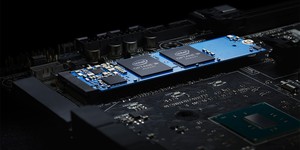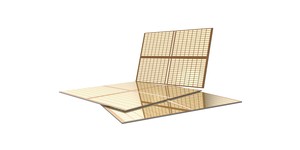
Intel and Micron have announced the fruit of a joint project, 3D XPoint, which it claims can replace the NAND flash used in solid-state storage devices and offer a thousand times the performance.
Like NAND flash, 3D XPoint is a non-volatile memory component designed for permanent storage of data. Unlike NAND flash, however, Intel claims its performance is suitable for use as working memory as well - making it a potential candidate for the long-sought-after 'universal memory' that would do away with the distinction between RAM and data storage. As well as being up to a thousand times faster than the latency of NAND flash, it is only slightly slower than traditional DRAM - and has the benefit of being non-volatile and offering significantly improved density, fitting between eight and ten times the data storage capacity into the same footprint as DRAM modules.
'For decades, the industry has searched for ways to reduce the lag time between the processor and data to allow much faster analysis,' claimed Rob Crooke, senior vice president and general manager of Intel's Non-Volatile Memory Solutions Group, of the new technology. 'This new class of non-volatile memory achieves this goal and brings game-changing performance to memory and storage solutions.'
'One of the most significant hurdles in modern computing is the time it takes the processor to reach data on long-term storage,' agreed Mark Adams, president of Micron. 'This new class of non-volatile memory is a revolutionary technology that allows for quick access to enormous data sets and enables entirely new applications.'
Intel claims that 3d XPoint was 'built from the ground-up' to be a high-performance, non-volatile and high-endurance replacement for both high-capacity storage and system RAM. Intriguingly, the technology is entirely transistorless, featuring perpendicular conductors connecting 128 billion densely-packed single-bit memory cells in a lattice which is stacked two-high to form a 128Gb die and using variable-voltage selectors instead of transistors to access cells for read and write operations. Future generations, Micron has claimed, will increase the stackability as a means of boosting capacity, along with the usual lithographic process node scaling that takes place in the semiconductor industry.
Intel is clear that 3D XPoint is a real alternative to NAND flash and DRAM for big-data applications, claiming that the non-volatile memory is inexpensive and high-endurance - 'not significantly impacted by the number of write cycles it can endure,' to be precise, though no firm figures have yet been released.
While DRAM still has the edge in performance, and is unlikely to disappear for uses like processor cache and graphics memory, Intel and Micron are clearly betting heavily on 3D XPoint for the future of computing. A presentation on the technology, which is due to sample with 'select customers' later this year ahead of commercial implementations from both Intel and Micron with no firm launch date, is reproduced below.
Like NAND flash, 3D XPoint is a non-volatile memory component designed for permanent storage of data. Unlike NAND flash, however, Intel claims its performance is suitable for use as working memory as well - making it a potential candidate for the long-sought-after 'universal memory' that would do away with the distinction between RAM and data storage. As well as being up to a thousand times faster than the latency of NAND flash, it is only slightly slower than traditional DRAM - and has the benefit of being non-volatile and offering significantly improved density, fitting between eight and ten times the data storage capacity into the same footprint as DRAM modules.
'For decades, the industry has searched for ways to reduce the lag time between the processor and data to allow much faster analysis,' claimed Rob Crooke, senior vice president and general manager of Intel's Non-Volatile Memory Solutions Group, of the new technology. 'This new class of non-volatile memory achieves this goal and brings game-changing performance to memory and storage solutions.'
'One of the most significant hurdles in modern computing is the time it takes the processor to reach data on long-term storage,' agreed Mark Adams, president of Micron. 'This new class of non-volatile memory is a revolutionary technology that allows for quick access to enormous data sets and enables entirely new applications.'
Intel claims that 3d XPoint was 'built from the ground-up' to be a high-performance, non-volatile and high-endurance replacement for both high-capacity storage and system RAM. Intriguingly, the technology is entirely transistorless, featuring perpendicular conductors connecting 128 billion densely-packed single-bit memory cells in a lattice which is stacked two-high to form a 128Gb die and using variable-voltage selectors instead of transistors to access cells for read and write operations. Future generations, Micron has claimed, will increase the stackability as a means of boosting capacity, along with the usual lithographic process node scaling that takes place in the semiconductor industry.
Intel is clear that 3D XPoint is a real alternative to NAND flash and DRAM for big-data applications, claiming that the non-volatile memory is inexpensive and high-endurance - 'not significantly impacted by the number of write cycles it can endure,' to be precise, though no firm figures have yet been released.
While DRAM still has the edge in performance, and is unlikely to disappear for uses like processor cache and graphics memory, Intel and Micron are clearly betting heavily on 3D XPoint for the future of computing. A presentation on the technology, which is due to sample with 'select customers' later this year ahead of commercial implementations from both Intel and Micron with no firm launch date, is reproduced below.

MSI MPG Velox 100R Chassis Review
October 14 2021 | 15:04








Want to comment? Please log in.